Initiating HERMÓPOLIS Collaborative Design: Local Definitions for Building a Global Smart City Platform to Improve the Quality of Life of the Elderly †
Abstract
1. Introduction
2. Materials and Methods
2.1. Literature Review
2.1.1. Smart Cities and Ageing
2.1.2. Smart Furniture and Ageing
2.1.3. The Extended Interconnected Public Space Concept
2.1.4. Participatory Design and Age-Friendly Environments and Communities
2.1.5. Layered Design and Age-Friendly Environments and Communities
2.2. Methodological Approach
2.2.1. Architectonic and Artistic Layer
2.2.2. Technological Layer
- Activities service: This service is the digital support of the activities for elderly users. These activities include cognitive exercises, online therapy sessions, physical exercises and social engagements. A key feature of this service is its ability to provide personalized activities based on the needs and preferences of each user, promoting engagement and active participation, which is essential for maintaining cognitive and physical health.
- Teleconference and translation services: These services provide remote teleconferencing features that enable users to remotely interact with other elders, the supervision staff and other personnel involved in the activities. The inclusion of automatic translation services breaks down language barriers, making the platform accessible to a diverse user base. This feature is particularly useful for multicultural environments, where elderly individuals may speak different languages or come from varied linguistic backgrounds.
- Management services: This service handles the logistical aspects of activity scheduling and organization. It ensures that both users and supervisory staff have access to updated information about upcoming activities. Elderly users can receive notifications and reminders for activities, which helps them stay on track, while staff members can use the platform to monitor participation and outcomes.
- Artificial intelligence (AI) services: The AI services provide advanced analytics that can significantly enhance the experience and safety of elderly users. For instance, AI-powered human posture estimation (HPE) and emotion recognition tools are crucial for remote online interaction. On the one hand, they allow the capture and exchange of users’ physical movements and emotions from one place to another for engaging them in remote interactions. On the other hand, they enable staff to monitor physical activities and emotional states in real time. Therefore, they not only ensure that exercises and therapy sessions are performed correctly but also provide insights into the emotional well-being of participants, allowing for timely interventions if distress or discomfort is detected.
Initial Development of the Technological Layer
Human Posture Estimation (HPE) Application Development
2.2.3. Activities and Social Layers
2.3. Design Process
- Recruitment of the participants
- Realization of the initial hybrid sessions to observe whether the groups effectively communicate and their relationship with technology
- Realization of the initial collaborative design activities: identification of their architectural design preferences and needs regarding their quality of life.
2.3.1. Recruitment of the Participants
- Group 1. The first group is from Peñaflor de Hornija, a municipality located in the province of Valladolid, Castile, and León, Spain. According to the 2023 census (INE), the municipality has a population of 337 inhabitants. The group of elders is composed of nine persons (five women and four men), ranging in age from 65 to 70. Most of them live in Peñaflor, although some of them are not yet retired and commute to work in Valladolid.
- Group 2. The second group is from Santa Cruz de Tenerife, the capital of the island of Tenerife and one of the capitals of the Canary Islands. The city has a population of 209,395 inhabitants (2023) and is part of a metropolitan area of almost 500,000 inhabitants, formed by Santa Cruz de Tenerife and San Cristóbal de la Laguna. The group of seniors is made up of five people (four women and one man) with an age range of 55 to 74 years, representing a group of 18 volunteers. They are part of the Cáritas Castrense association, which focuses on the inclusion and integration of elderly retired Army personnel, mainly widows and orphans. The members of this group have a higher university education and show a more technical interest oriented to architecture, since part of their actions have to do with the provision of home help, adaptation of facilities and studies on the suitability of spaces for their actions.
- Group 3. The third group is from Espiñoso (officially called San Miguel de Espiñoso), a parish in the municipality of Cartelle, in the province of Orense, Galicia. The parish has a population of 188 inhabitants (2022). The group of seven women represents the Rural Women Association of San Miguel de Espiñoso. The age range is from 55 to 80 years old. Some live in big cities such as Madrid, Vigo or A Coruña half of the year, dwelling in the parish the rest of the year.
2.3.2. Realization of the Initial Sessions
2.3.3. Initial Collaborative Design Activities
Architectonic Design Preferences
- Questionnaire 1 was administered to Peñaflor and Espiñoso participants to capture their general architectonic preferences about indoor and outdoor activities, the specific list of the activities (that they currently do), the preferred places to engage in these activities, and finally, they were asked about Metaverse.
- Additionally, a detailed guide of architectonic design preferences (Questionnaire 2) was administered to the three groups.
Quality of Life and Related Needs
3. Results
3.1. Preferences for Outdoor and Indoor Activities
- A.
- Sevillanas (flamenco dancing), Zumba classes, yoga, physical exercises
- B.
- Bobbin, workshops (memory and laughter therapy), summer public talks, classes (e.g., on the use of technology and active listening)
- C.
- Cooking lessons
- D.
- Nordic walking, excursions, hiking, bike riding
3.2. Preferences About the Architectonic Space for Indoor Activities
3.3. Identification of the Principal Needs Related to Their Quality of Life
- There is an interest in mastering technological tools for daily life; also, there is curiosity about learning AI. The inability to use technology makes them afraid of making online appointments for medical assistance, carrying out bank and city hall procedures, etc.
- A strong interest in increasing the medical assistance received, especially mental.
- Loneliness was an expressed issue. To have a recreational–cultural–social space to interact with others.
- Regarding connectivity, Espiñoso and Peñaflor have an optical fiber service but do not have mobile phone service yet.
- One person expressed the feeling that technology can also divide and isolate people and the need for bigger social cohesion and face-to-face communication.
- Architectonic barriers are also a detected issue for making public spaces accessible.
- The need for professional carers was also detected.
- Improvement of the communication and transport services in the rural environment. Improvement of the maintenance and accessibility of public spaces (e.g., parks).
- A need to learn languages that can be very useful for communicating with foreign people.
- The need for entertainers who encourage elderly people to engage in cheerful activities was also expressed.
3.4. Conceptual Comparison of the Obtained Results
3.4.1. Outdoor Activities and Potential Interest in IP-Spaces
3.4.2. Architectural Preferences
4. Discussion
4.1. Communication Effectiveness and Its Main Barriers (Social Layer)
4.2. Definition of the Initial Architectural and Technological Specifications of the Design
4.3. Identification of Needs and Definition of the First Activities to Be Implemented
- Technological assistance. Teaching them how to use technology
- Mental health assistance.
- Increase their social interaction.
5. Conclusions
- Architectonic and artistic layer. Build a detachable pavilion, an architectonic object able to shelter outdoor smart furniture dynamically depending on the weather conditions. This design should be adapted to the specific conditions (demographics, geographic, climate and cultural conditions of each town), validating its use during the elderly’s activities.
- Technological layer. Continuing the development of the human posture estimation to make online physical activities interactive, validating its use during elderly activities.
- Activities layer. Design and implement the three initial activities selected: teaching about the use of technology to alleviate the digital divide, prospecting resources to implement mental health assistance to these specific groups and designing and implementing activities for increasing their social interaction. Assess the impact of these activities on the well-being and quality of life of the elderly.
- Social layer. Increase the diffusion and recruitment of more participants to increase the social base of the project. Apply the obtained insight and continue the research to produce effective online communication.
Author Contributions
Funding
Institutional Review Board Statement
Informed Consent Statement
Data Availability Statement
Acknowledgments
Conflicts of Interest
References
- World Health Organization. Active Ageing. A Policy Framework. 2002. Available online: https://extranet.who.int/agefriendlyworld/wp-content/uploads/2014/06/WHO-Active-Ageing-Framework.pdf (accessed on 11 May 2025).
- World Health Organization. Decade of Healthy Ageing: Plan of Action. 2020. Available online: https://www.who.int/publications/m/item/decade-of-healthy-ageing-plan-of-action (accessed on 11 May 2025).
- World Health Organization. Data Platform. Number of Countries with National Plans, Policies or Strategies on Ageing and Health. Available online: https://platform.who.int/data/maternal-newborn-child-adolescent-ageing/indicator-explorer-new/MCA/number-of-countries-with-national-plans-policies-or-strategies-on-ageing-and-health (accessed on 15 December 2024).
- Department of Economic and Social Affairs, United Nations. World Social Report. 2023: Living No One Behind in an Ageing World; United Nations: New York, NY, USA, 2019; p. 17. Available online: https://www.un.org/development/desa/dspd/wp-content/uploads/sites/22/2023/01/2023wsr-chapter1-.pdf (accessed on 11 May 2025).
- Padrón Nápoles, V.M.; Esteban Penelas, J.L.; Pizarro Juanas, E.; López Arquillo, J.D.; Delgado Pérez, E.; Bellido, A.; Muñoz Gil, R.; García Pérez, O.; Martínez García, P.; Loscertales, I.; et al. The design of HERMOPOLIS: An architectonic, artistic, technological, entertainment, health and social Smart Cities platform oriented to improve quality of life of the elder people. In Proceedings of the VI Ibero-American Congress of Smart Cities, CITIES, Mexico City and Cuernavaca, Mexico, 13–17 November 2023; Moreno-Bernal, P., Escamilla-Ambrosio, P., Hernández-Callejo, L., Nesmachnow, S., Rossit, D., Torres-Aguilar, C., Eds.; Universidad Europea de Madrid: Madrid, Spain, 2023. [Google Scholar]
- Department of Economic and Social Affairs, United Nations. Population Division. World Population Prospects 2024. 2024. Available online: https://population.un.org/wpp/graphs?loc=900&type=Probabilistic%20Projections&category=Pop%20Percentages&subcategory=Age%2065%20and%20over (accessed on 10 May 2025).
- Instituto Nacional de Estadística. Proyecciones de Población 2022–2072. Notas de Prensa. 2022. Available online: https://www.ine.es/prensa/pp_2022_2072.pdf (accessed on 11 May 2025).
- Eurostat. Government Expenditure by Function. 29 February 2024. Available online: https://ec.europa.eu/eurostat/cache/visualisations/economy/government-expenditure/ (accessed on 11 May 2025).
- Instituto Nacional de Estadística. INEbase. Indicadores de Calidad de Vida. Riqueza Neta de los Hogares por Riqueza, Edad y Periodo. 2022. Available online: https://www.ine.es/jaxi/Tabla.htm?path=/t00/ICV/dim1/l0/&file=13102.px&L=0 (accessed on 13 May 2025).
- Waterworth, J.; Ballesteros, S.; Christian, P.; Bieber, G.; Kreiner, A.; Wiratanaya, A.; Polymenakos, L.; Wanche-Politis, S.; Capobianco, M.; Etxeberria, I.; et al. Ageing in a networked society—Social inclusion and mental stimulation. In Proceedings of the 2nd International Conference on Pervasive Technologies Related to Assistive Environments (PETRA 2009), Corfu, Greece, 9–13 June 2009. [Google Scholar]
- Wang, H.; Karp, A.; Winblad, B.; Fratiglioni, L. Late-Life Engagement in Social and Leisure Activities Is Associated with a Decreased Risk of Dementia: A Longitudinal Study from the Kungsholmen Project. Am. J. Epidemiol. 2002, 155, 1081–1087. [Google Scholar] [CrossRef] [PubMed]
- Santini, Z.I.; Jose, P.E.; Cornwell, E.Y.; Koyanagi, A.; Nielsen, L.; Hinrichsen, C.; Meilstrup, C.; Madsen, K.R.; Koushede, V. Social disconnectedness, perceived isolation, and symptoms of depression and anxiety among older Americans (NSHAP): A longitudinal mediation analysis. Lancet Public Health 2020, 5, e62–e70. [Google Scholar] [CrossRef] [PubMed]
- Cornwell, B.; Laumann, E.O. The health benefits of network growth: New evidence from a national survey of older adults. Soc. Sci. Med. 2015, 125, 94–106. [Google Scholar] [CrossRef] [PubMed]
- Lee, S.H.; Kim, Y.B. Which type of social activities may reduce cognitive decline in the elderly?: A longitudinal population-based study. BMC Geriatr. 2016, 16, 165. [Google Scholar] [CrossRef]
- Ijsselsteijn, W.; Nap, H.H.; de Kort, Y.; Poels, K. Digital Game Design for Elderly Users. In Proceedings of the Conference on Future Play—Future Play’07, Toronto, ON, Canada, 15–17 November 2007. [Google Scholar]
- World Bank. Global Urban and Rural Population Worldwide from 1990 to 2022 (in Billions) [Graph]. 28 March 2024. Available online: https://www.statista.com/statistics/267838/global-urban-and-rural-population/ (accessed on 14 December 2024).
- Buchholz, K. Then & Now: Urban Population Worldwide [Digital Image]. 30 October 2020. Available online: https://www.statista.com/chart/23349/share-of-urban-population-by-continent/ (accessed on 11 November 2024).
- Wendell Cox Consultancy. Distribution of Built-Up Areas with Population of 500,000 and Over Worldwide in 2023, by Region [Graph]. 31 August 2023. Available online: https://www.statista.com/statistics/1237327/share-of-urban-areas-region/ (accessed on 20 November 2024).
- Population Reference Bureau. Share of Urban Population Worldwide in 2023, by Continent [Graph]. 18 December 2023. Available online: https://www.statista.com/statistics/270860/urbanization-by-continent/ (accessed on 17 November 2024).
- Brandt, M. Urbane Riesen [Digitales Bild]. 10 July 2018. Available online: https://de.statista.com/infografik/14617/die-zehn-groessten-staedte-der-welt/ (accessed on 22 November 2024).
- World Health Organization. Global Age-Friendly Cities: A Guide; World Health Organization: Geneva, Switzerland, 2007; ISBN 9789241547307. [Google Scholar]
- Marston, H.R.; Van Hoof, J. “Who doesn’t think about technology when designing urban environments for older people?” A case study approach to a proposed extension of the WHO’s age-friendly cities model. Int. J. Environ. Res. Public Health 2019, 16, 3525. [Google Scholar] [CrossRef]
- Podgórniak-Krzykacz, A.; Przywojska, J.; Wiktorowicz, J. Smart and age-friendly communities in Poland. An analysis of institutional and individual conditions for a new concept of smart development of ageing communities. Energies 2020, 13, 2268. [Google Scholar] [CrossRef]
- Baraković, S.; Baraković Husić, J.; Van Hoof, J.; Krejcar, O.; Maresova, P.; Akhtar, Z.; Melero, F.J. Quality of life framework for personalised ageing: A systematic review of ICT solutions. Int. J. Environ. Res. Public Health 2020, 17, 2940. [Google Scholar] [CrossRef]
- Bergschöld, J.M.; Gunnes, M.; Eide, A.H.; Lassemo, E. Characteristics and Range of Reviews About Technologies for Aging in Place: Scoping Review of Reviews. JMIR Aging 2024, 7, e50286. [Google Scholar] [CrossRef]
- Szewczenko, A. The concept of smart city in terms of improving the quality and accessibility of urban space for the elderly; literature review. Archit. Civ. Eng. Environ. 2020, 13, 27–35. [Google Scholar] [CrossRef]
- Marques, B.; McIntosh, J.; Valera, A.; Gaddam, A. Innovative and assistive ehealth technologies for smart therapeutic and rehabilitation outdoor spaces for the elderly demographic. Multimodal. Technol. Interact. 2020, 4, 76. [Google Scholar] [CrossRef]
- Padrón-Nápoles, V.M.; Gachet Páez, D.; Esteban Penelas, J.L.; García Pérez, O.; García Santacruz, M.J.; Martín de Pablos, F. Smart bus stops as interconnected public spaces for increasing social inclusiveness and quality of life of elder users. Smart Cities 2020, 3, 430–443. [Google Scholar] [CrossRef]
- Padrón Nápoles, V.M.; Gachet Páez, D.; Esteban Penelas, J.L.; García Pérez, O.; Mar-tín de Pablos, F.; Muñoz Gil, R. Social inclusion in smart cities. In Handbook of Smart Cities; Augusto, J.C., Ed.; Springer: Cham, Swizterland, 2020. [Google Scholar] [CrossRef]
- Nápoles, V.M.P.; Páez, D.G.; Penelas, J.L.E.; García, G.G.; Santacruz, M.J.G. Bus Stops as a Tool for Increasing Social Inclusiveness in Smart Cities. In Smart Cities; Nesmachnow, S., Hernández Callejo, L., Eds.; ICSC-CITIES 2019. Communications in Computer and Information Science; Springer: Cham, Switzerland, 2019; Volume 1152. [Google Scholar] [CrossRef]
- Rocha, N.P.; Bastardo, R.; Pavao, J.; Santinha, G.; Rodrigues, M.; Rodrigues, C.; Queiros, A.; Dias, A. Smart Cities’ applications to facilitate the mobility of older adults: A systematic review of the literature. Appl. Sci. 2021, 11, 6395. [Google Scholar] [CrossRef]
- Szewczenko, A.; Lach, E.; Bursiewicz, N.; Chuchnowska, I.; Widzisz-Pronobis, S.; Sanigórska, M.; Elsner, K.; Bal, D.; Sutor, M.; Włodarz, J.; et al. Urban Therapy—Urban Health Path as an Innovative Urban Function to Strengthen the Psycho-Physical Condition of the Elderly. Int. J. Environ. Res. Public Health 2023, 20, 6081. [Google Scholar] [CrossRef]
- McIntosh, J.; Marques, B.; Cornwall, J.; Kershaw, C.; Mwipiko, R. Therapeutic Environments and the Role of Physiological Factors in Creating Inclusive Psychological and Socio-Cultural Landscapes. Ageing Int. 2022, 47, 433–446. [Google Scholar] [CrossRef]
- Pandita, D.; Choudhary, H. Biophilic designs: A solution for the psychological well-being and quality of life of older people. Work. Older People 2024, 28, 417–427. [Google Scholar] [CrossRef]
- Boavida, J.; Ayanoglu, H.; Pereira, C.V.; Hernandez-Ramirez, R. Active Aging and Smart Public Parks. Geriatrics 2023, 8, 94. [Google Scholar] [CrossRef] [PubMed]
- Tian, P.; Kim, S.; Wang, J. Research on the Elderly Friendly Park Based on Inclusive Design Concept. Front. Art Res. 2020, 2, 56–61. [Google Scholar]
- Jaekyoung, K.; Jung-Min, L.; Junsuk, K. Smart cities and disaster risk reduction in South Korea by 2022: The case of Daegu. Heliyon 2023, 9, e18794. [Google Scholar] [CrossRef]
- Martín de Pablos, F.; Padrón Nápoles, V.M.; Gachet Páez, D.; Esteban Penelas, J.L.; García Pérez, O.; Muñoz Gil, R.; García González, J.; Escorial Santa Marina, S. Human-Computer Interfaces for Smart Bus Stops as Interconnected Public Spaces (IP-Spaces) elements in Smart Cities. In Proceedings of the III Ibero-American Conference on Smart Cities, San José, Costa Rica, 9–11 November 2020. [Google Scholar]
- Holosonics. Focused Sound Experiences with Digital Signage. Available online: https://www.holosonics.com/applications/digital-signage (accessed on 11 January 2025).
- Satte, F.C.S. Smart Outdoors: A Proposal for a Public Park in Campo de Ourique. Ph.D. Thesis, IADE, Faculdade de Design, Tecnologia e Comunicação da Universidade Europeia, Lisbon, Portugal, 2021. [Google Scholar]
- Loukaitou-Sideris, A. Smart Playgrounds? Using Smart and Interactive Technologies to Combat Playground Underutilization. Built Environ. 2021, 47, 243–263. [Google Scholar] [CrossRef]
- Jun, J. Towards a Smarter Urban Park: Busan Citizens Park. Designs 2023, 7, 6. [Google Scholar] [CrossRef]
- Bacon, N.; Brophy, M.; Mguni, M.; Mulgan, G.; Shandro, A. The State of Happiness: Can Public Policy Shape People’s Wellbeing and Resilience? The Young Foundation: London, UK, 2010; Available online: https://youngfoundation.org/wp-content/uploads/2012/10/The-State-of-Happiness.pdf (accessed on 11 December 2024).
- WHO. Regional Office for Europe. Active Ageing: Physical Activity Promotion in Elderly. Available online: https://www.who.int/europe/groups/hepa-europe-(european-network-for-the-promotion-of-health-enhancing-physical-activity)/hepa-europe-events-and-working-groups/active-ageing--physical-activity-promotion-in-elderly (accessed on 11 May 2025).
- Archer, L.; Davidson, S.; Iparraguirre, J.; Kohler, M.; Pursch, B.; Vass, J.; Curran, F. Creative and Cultural Activities and Wellbeing in Later Life; Age UK Policy and Research Department and Age UK: Oxfordshire, UK, 2018; Available online: https://www.ageuk.org.uk/creativewellbeing (accessed on 22 December 2024).
- The New York Academy of Medicine. Building Community through Arts and Culture. Available online: https://extranet.who.int/agefriendlyworld/wp-content/uploads/2020/01/AF-Arts-Guide-PRINT-FINAL.pdf (accessed on 11 May 2025).
- Ryu, J.; Heo, J. Relationships between leisure activity types and well-being in older adults. Leis. Stud. 2018, 37, 331–342. [Google Scholar] [CrossRef]
- Toepoel, V. Cultural participation of older adults: Investigating the contribution of lowbrow and highbrow activities to social integration and satisfaction with life. Int. J. Disabil. Hum. Dev. 2011, 10, 123–129. [Google Scholar] [CrossRef]
- Sheppard, A.; Broughton, M.C. Promoting wellbeing and health through active participation in music and dance: A systematic review. Int. J. Qual. Stud. Health Well-Being 2020, 15, 1732526. [Google Scholar] [CrossRef]
- Popovic, S.; Masanovic, B. Effects of Physical and Social Activity on Physical Health and Social Inclusion of Elderly People. Iran. J. Public Health 2019, 48, 1922–1923. [Google Scholar] [CrossRef]
- Leanos, S.; Kürüm, E.; Strickland-Hughes, C.M.; Ditta, A.S.; Nguyen, G.; Felix, M.; Yum, H.; Rebok, G.W.; Wu, R. The Impact of Learning Multiple Real-World Skills on Cognitive Abilities and Functional Independence in Healthy Older Adults. J. Gerontol. B Psychol. Sci. Soc. Sci. 2023, 78, 1305–1317. [Google Scholar] [CrossRef] [PubMed] [PubMed Central]
- Freeman, S.; Marston, H.R.; Olynick, J.; Musselwhite, C.; Kulczycki, C.; Genoe, R.; Xiong, B. Intergenerational effects on the impacts of technology use in later life: Insights from an international, multi-site study. Int. J. Environ. Res. Public Health 2020, 17, 5711. [Google Scholar] [CrossRef] [PubMed]
- Kokubun, K.; Ogawa, T.; Browne, R.; Shinada, T.; Granrath, L.; Moeller, J.; Tram, N.; Wieching, R.; Taki, Y. Social capital mediates the association between the ICT usage and well-being of older people in Japan: Implication for a new design paradigm. Sustainability 2022, 14, 4148. [Google Scholar] [CrossRef]
- Bonaccorsi, G.; Manzi, F.; Del Riccio, M.; Setola, N.; Naldi, E.; Milani, C.; Giorgetti, D.; Dellisanti, C.; Lorini, C. Impact of the built environment and the neighborhood in promoting the physical activity and the healthy aging in older people: An umbrella review. Int. J. Environ. Res. Public Health 2020, 17, 6127. [Google Scholar] [CrossRef]
- Pedell, S.; Borda, A.; Keirnan, A.; Aimers, N. Combining the digital, social and physical layer to create age-friendly cities and communities. Int. J. Environ. Res. Public Health 2021, 18, 325. [Google Scholar] [CrossRef]
- Spinuzzi, C. The methodology of participatory design. Tech. Commun. 2005, 52, 163–174. [Google Scholar]
- Baum, F.; MacDougall, C.; Smith, D. Participatory action research. J. Epidemiol. Community Health 2006, 60, 854. [Google Scholar] [CrossRef] [PubMed]
- Lenette, C. What Is Participatory Action Research? Contemporary Methodological Considerations. In Participatory Action Research: Ethics and Decolonization; Oxford Academic: New York, NY, USA, 2022. [Google Scholar] [CrossRef]
- Martinez, J.; Hossain, R.; Romero, J.; Little, J.J. A simple yet effective baseline for 3D human pose estimation. In Proceedings of the IEEE International Conference on Computer Vision, Venice, Italy, 22–29 October 2017; pp. 2640–2649. [Google Scholar]
- Wang, J.; Qiu, K.; Peng, H.; Fu, J.; Zhu, J. AI coach: Deep human pose estimation and analysis for personalized athletic training assistance. In Proceedings of the 27th ACM International Conference on Multimedia, Nice, France, 21–25 October 2019; pp. 374–382. [Google Scholar]
- Park, H.J.; Baek, J.W.; Kim, J.H. Imagery based Parametric Classification of Correct and Incorrect Motion for Push-up Counter Using OpenPose. In Proceedings of the 2020 IEEE 16th International Conference on Automation Science and Engineering (CASE), Hong Kong, China, 20–21 August 2020; pp. 1389–1394. [Google Scholar]
- Patil, A.; Rao, D.; Utturwar, K.; Shelke, T.; Sarda, E. Body Posture Detection and Motion Tracking using AI for Medical Exercises and Recommendation System. ITM Web Conf. 2022, 44, 03043. [Google Scholar] [CrossRef]
- Devanandan, M.; Rasaratnam, V.; Anbalagan, M.K.; Asokan, N.; Panchendrarajan, R.; Tharmaseelan, J. Cricket Shot Image Classification Using Random Forest. In Proceedings of the 2021 3rd International Conference on Advancements in Computing (ICAC), Colombo, Sri Lanka, 9–11 December 2021; pp. 425–430. [Google Scholar]
- Chung, J.L.; Ong, L.Y.; Leow, M.C. Comparative analysis of skeleton-based human pose estimation. Future Internet 2022, 14, 380. [Google Scholar] [CrossRef]
- Pérez Pérez, M. Espacios Públicos Interconectados y el Bienestar de las Personas Mayores. Master’s Thesis, Universidad Europea de Madrid, Madrid, Spain, 2024. [Google Scholar]
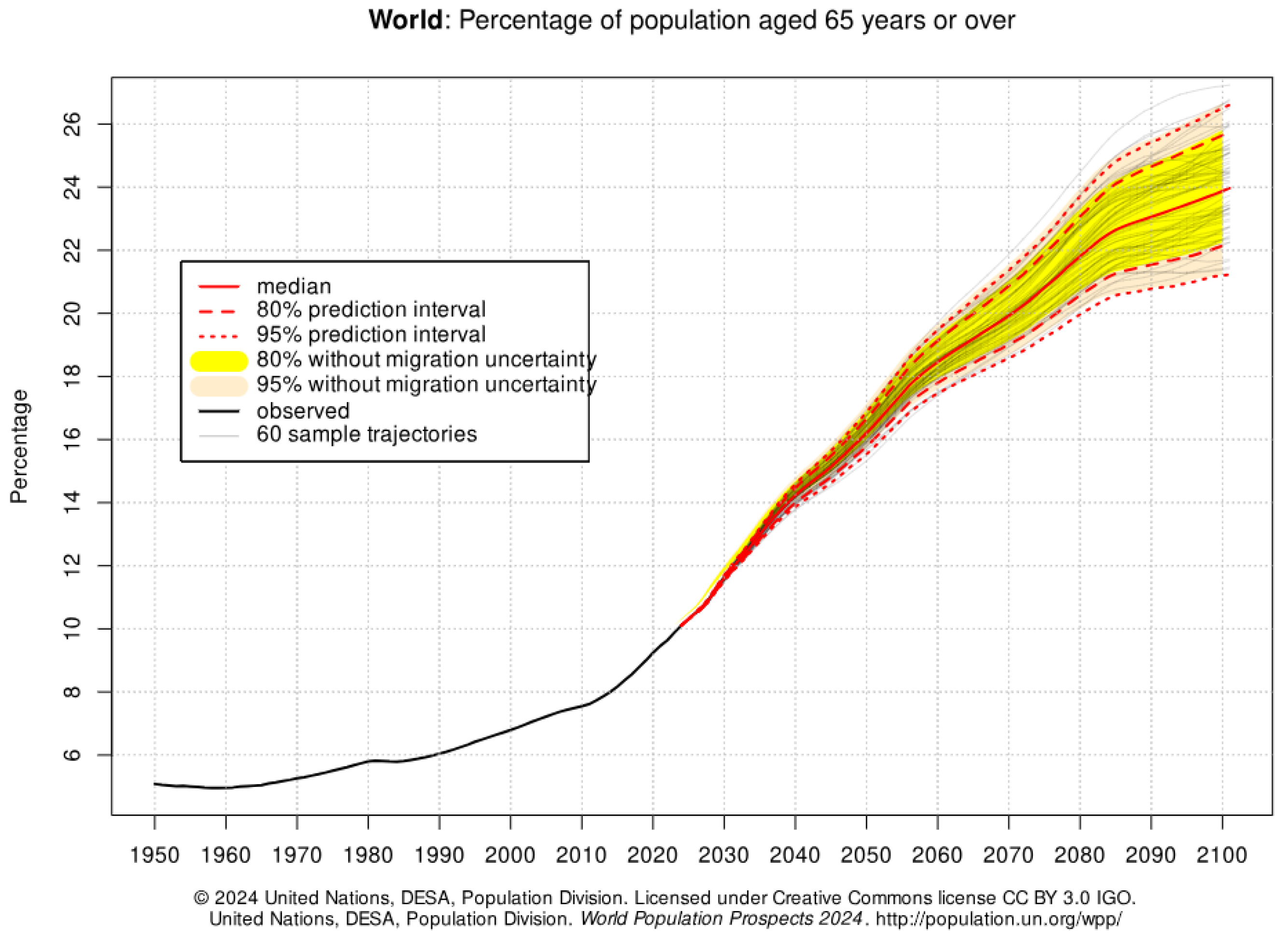


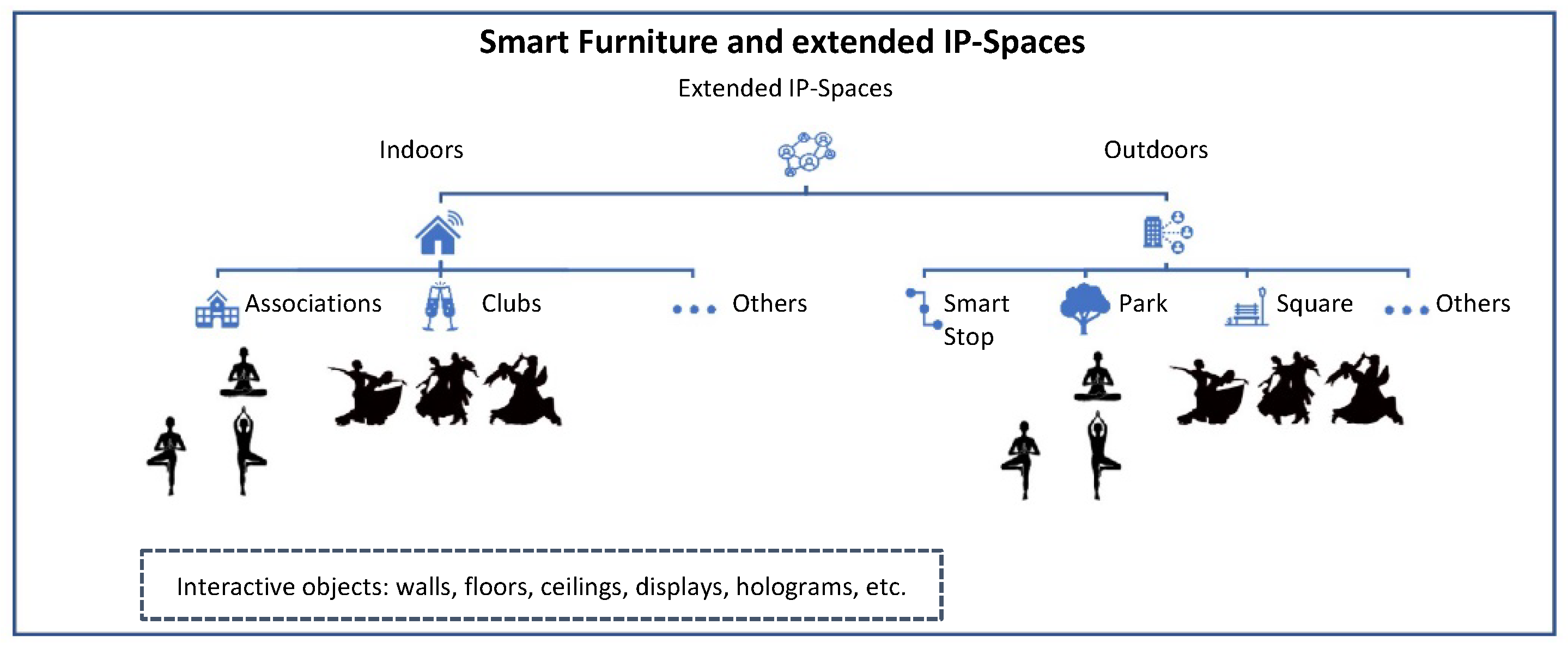
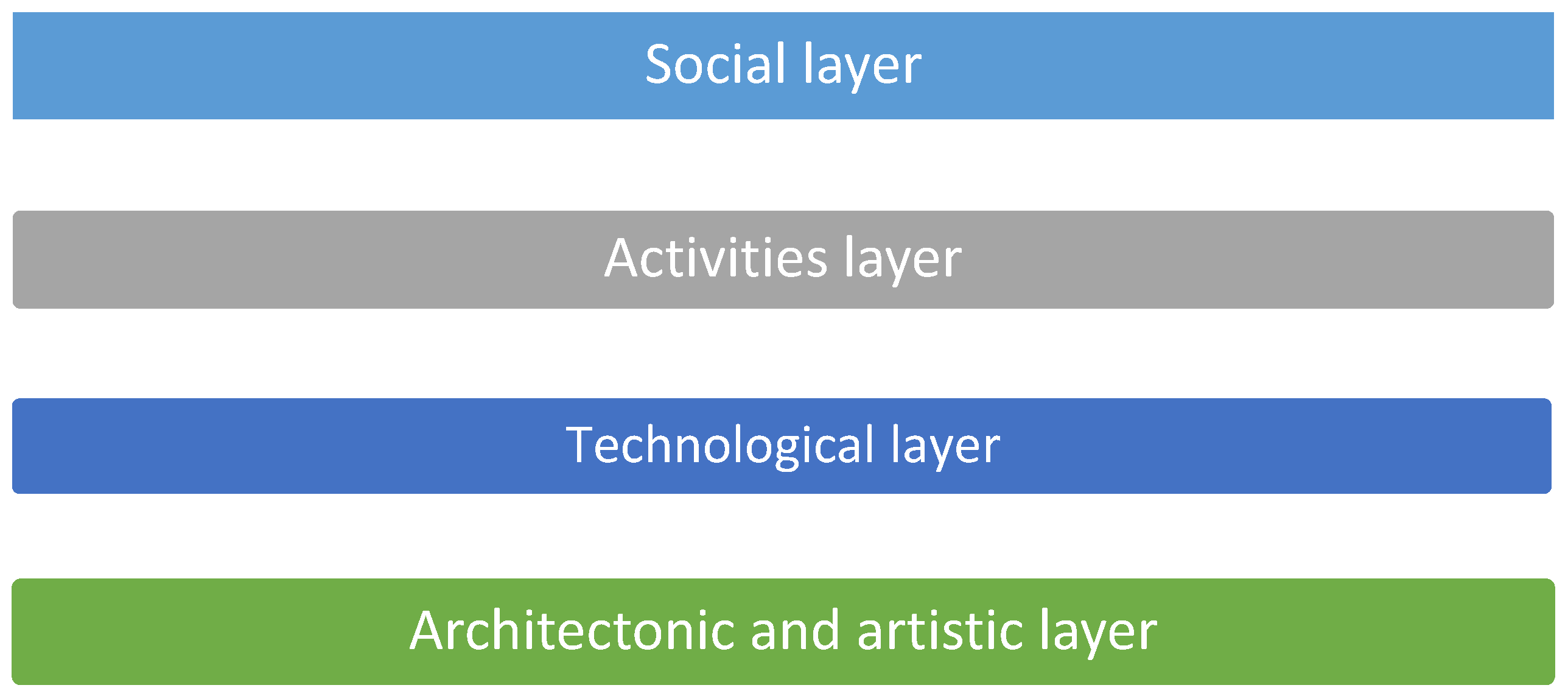

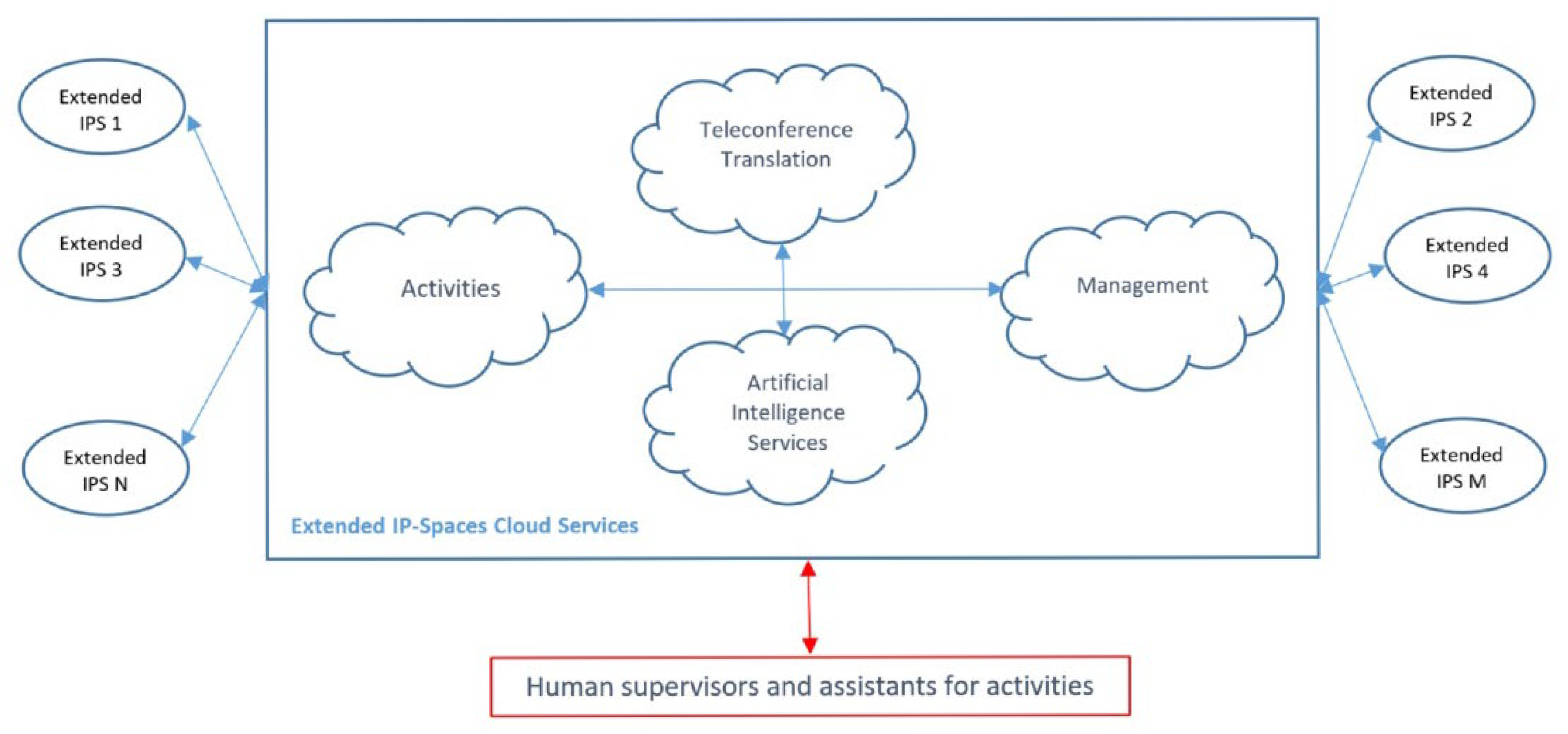


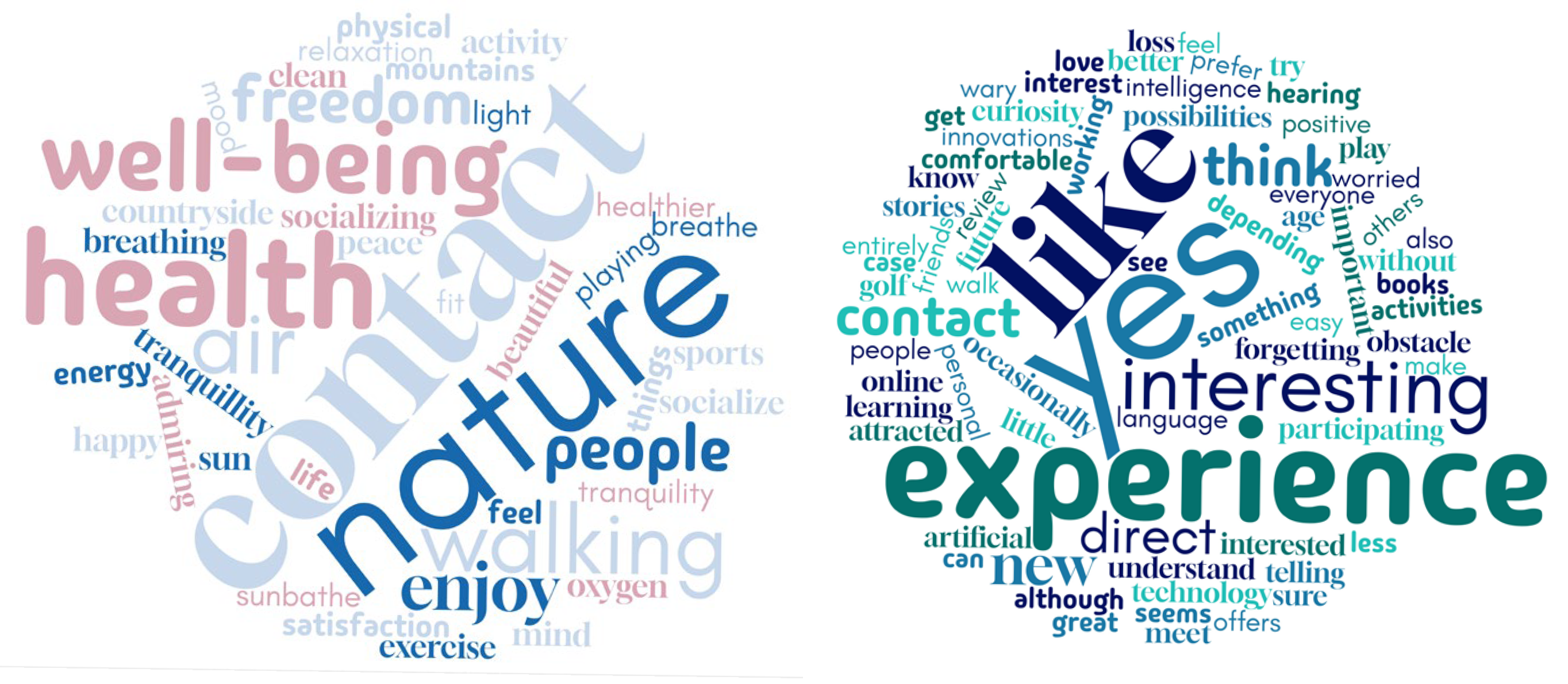
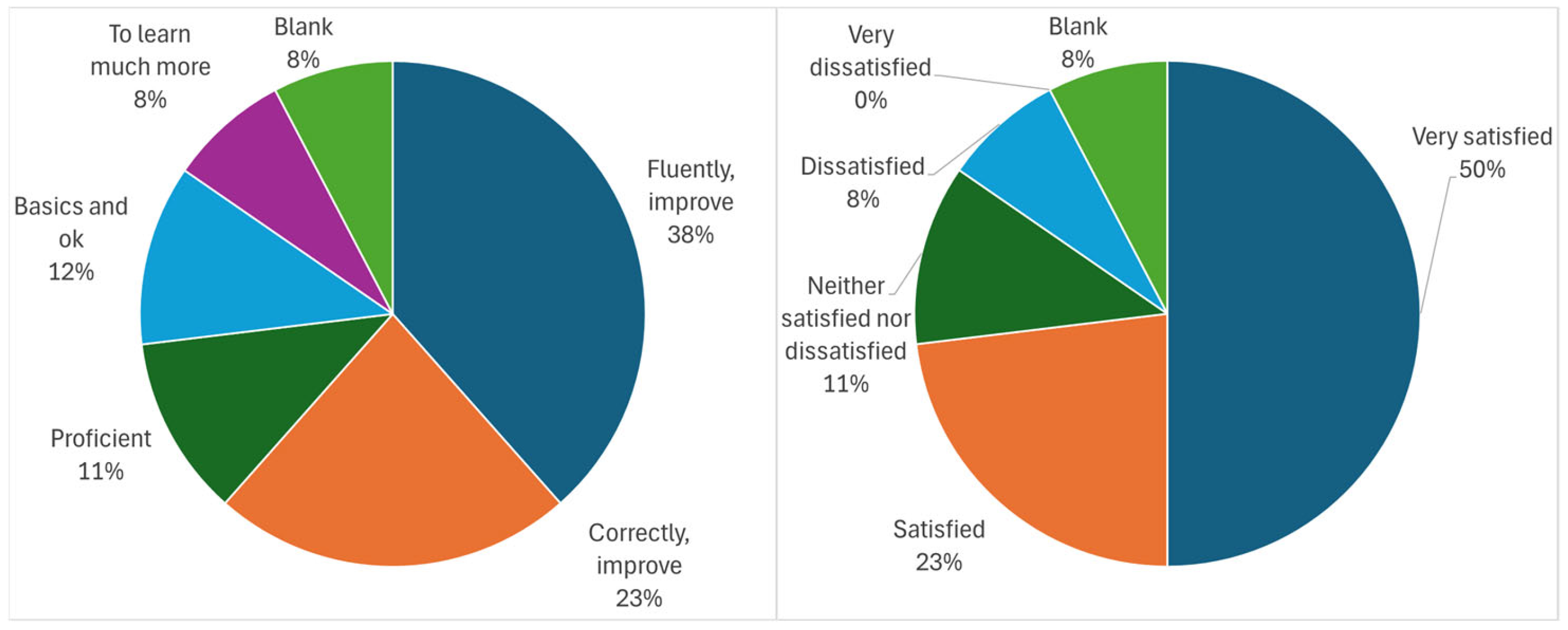
| Locality | Province/Autonomous Community | Population (Approx.) |
|---|---|---|
| San Agustín de Guadalix | Madrid | 14,000 |
| Aguilafuente | Segovia (Castilla y León) | 500 |
| Madrid | Madrid | 3,416,771 |
| El Molar | Madrid | 10,000 |
| Bilbao | Bizkaia (Basque Country) | 348,000 |
| Teo | A Coruña (Galicia) | 18,500 |
| Colmenar Viejo | Madrid | 57,000 |
| Alicante | Alicante (Valencian Community) | 358,720 |
| Manzanares el Real | Madrid | 9500 |
| Soto del Real | Madrid | 9400 |
| Úbeda | Jaén (Andalucía) | 33,600 |
| Albacete | Albacete (Castilla La Mancha) | 174,000 |
| Tabanera la Luenga | Segovia (Castilla y León) | 53 |
| Preferences | Values (Study 1) | Values (Study 2) |
|---|---|---|
| Dimensions | 100 m2 and 200 m2 | 100 m2 (46%), 200 m2 (23%) |
| Capacity | Up to 40 people | 20 people (50%), 40 people (23%) |
| Intergenerational space | Positive feelings were expressed | Yes (88%) |
| Shapes | Spaces with rectilinear shapes, smooth walls | Rectilinear walls (69%), ceilings with acoustic and curved shapes (77%) |
| Colors. | In general, warm colors or neutral colors (grays and whites) are preferred | Neutral colors (69.5%) |
| Materials | Different materials can be combined, but the result should be welcoming and should be easy to maintain, clean and disinfect | Natural, wood-like materials such as cork, etc., on walls, floors and ceilings (65%), combined with stony materials (30%) |
| Division of spaces | Shared spaces with sliding doors and walls provide great versatility, depending on the capacity and the activity | Yes (73%) |
| Roof Skylights | Yes; they can be screened or closed | Yes (92%) |
| Pavilion | Divided opinion | Yes (80%) |
Disclaimer/Publisher’s Note: The statements, opinions and data contained in all publications are solely those of the individual author(s) and contributor(s) and not of MDPI and/or the editor(s). MDPI and/or the editor(s) disclaim responsibility for any injury to people or property resulting from any ideas, methods, instructions or products referred to in the content. |
© 2025 by the authors. Licensee MDPI, Basel, Switzerland. This article is an open access article distributed under the terms and conditions of the Creative Commons Attribution (CC BY) license (https://creativecommons.org/licenses/by/4.0/).
Share and Cite
Padrón Nápoles, V.M.; Esteban Penelas, J.L.; Pizarro Juanas, E.; López-Arquillo, J.D.; Delgado-Pérez, E.; Bellido-Esteban, A.; Muñoz Gil, R.; García Pérez, O.; Martínez García, P.; Loscertales, I.; et al. Initiating HERMÓPOLIS Collaborative Design: Local Definitions for Building a Global Smart City Platform to Improve the Quality of Life of the Elderly. Urban Sci. 2025, 9, 174. https://doi.org/10.3390/urbansci9050174
Padrón Nápoles VM, Esteban Penelas JL, Pizarro Juanas E, López-Arquillo JD, Delgado-Pérez E, Bellido-Esteban A, Muñoz Gil R, García Pérez O, Martínez García P, Loscertales I, et al. Initiating HERMÓPOLIS Collaborative Design: Local Definitions for Building a Global Smart City Platform to Improve the Quality of Life of the Elderly. Urban Science. 2025; 9(5):174. https://doi.org/10.3390/urbansci9050174
Chicago/Turabian StylePadrón Nápoles, Víctor Manuel, José Luis Esteban Penelas, Esther Pizarro Juanas, Juan Diego López-Arquillo, Esther Delgado-Pérez, Alberto Bellido-Esteban, Rafael Muñoz Gil, Olalla García Pérez, Patricio Martínez García, Ignacio Loscertales, and et al. 2025. "Initiating HERMÓPOLIS Collaborative Design: Local Definitions for Building a Global Smart City Platform to Improve the Quality of Life of the Elderly" Urban Science 9, no. 5: 174. https://doi.org/10.3390/urbansci9050174
APA StylePadrón Nápoles, V. M., Esteban Penelas, J. L., Pizarro Juanas, E., López-Arquillo, J. D., Delgado-Pérez, E., Bellido-Esteban, A., Muñoz Gil, R., García Pérez, O., Martínez García, P., Loscertales, I., Álvarez Menéndez, S., & Arteaga Orozco, M. B. (2025). Initiating HERMÓPOLIS Collaborative Design: Local Definitions for Building a Global Smart City Platform to Improve the Quality of Life of the Elderly. Urban Science, 9(5), 174. https://doi.org/10.3390/urbansci9050174






